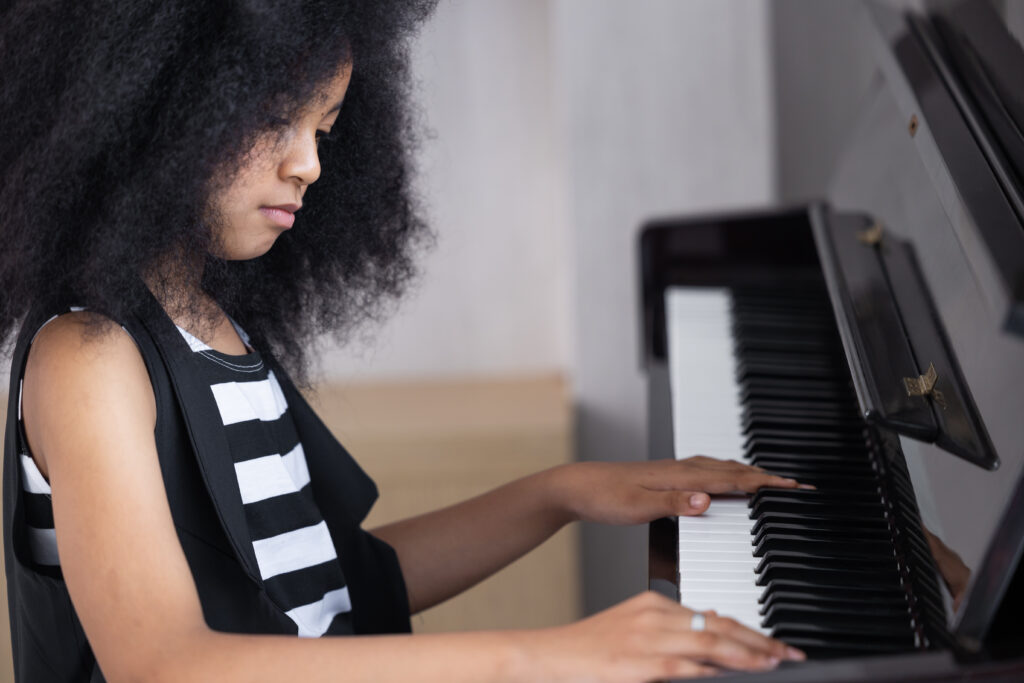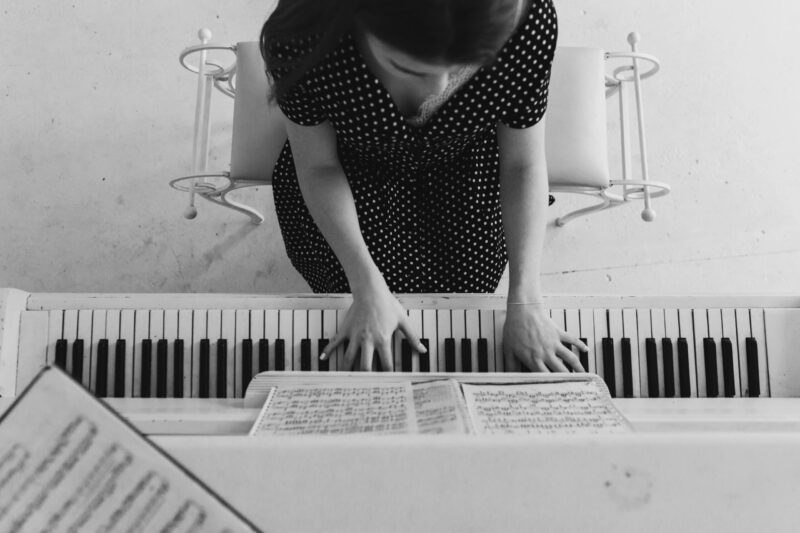Ticking to the Tune: Mastering the Best Time for Piano Practice
As the sun sets, casting a warm glow through the window into a serene room with a grand piano, the stage is set for a harmonious journey. The keys glisten in the soft light, exuding an air of tranquillity and anticipation, beckoning to be played in the peaceful ambience.
When it comes to the art of practising the piano, timing becomes the orchestrator of progress and performance. Whether you’re a novice or a seasoned pianist, the quest for the ideal practice time becomes a pivotal pursuit. In this article, we embark on an exploration of the factors that shape the perfect timing for piano practice, offering insights to elevate your practice sessions to new heights.

Amidst the symphony of considerations, your schedule emerges as a guiding force, directing the cadence of your practice sessions. The quest for an uninterrupted sanctuary becomes paramount, leading you to seek the early morning calm or the tranquil embrace of a quiet night. Ultimately, the best time to practice becomes a reflection of your unique rhythm and lifestyle, guiding you to the ideal moment for musical immersion.
Yet, in this pursuit, the ebb and flow of your energy becomes a vital companion, guiding the crescendo of your practice. The quest for alertness and vitality becomes a guiding force, urging you to seek the moments after restful slumber or invigorating physical activity. By heeding these harmonious cues, you can unlock the perfect time to practice the piano and infuse your sessions with the essence of your fullest potential.
Understanding Circadian Rhythms
When it comes to practising the piano, understanding your body’s circadian rhythms can be beneficial in determining the best time to practice. Circadian rhythms are physical, mental, and behavioural changes that follow a 24-hour cycle, responding primarily to light and darkness in an organism’s environment.
Identifying Your Peak Hours
Everyone’s circadian rhythms are different, and identifying your peak hours can help you determine when you are most alert and focused. For some people, their peak hours may be in the morning, while others may find that they are most alert in the afternoon or evening.
To identify your peak hours, keep track of when you feel most alert and productive throughout the day. Take note of any patterns and try to schedule your practice sessions during these peak hours.
Influence of Natural Light
Natural light can also influence your circadian rhythms and affect your energy levels throughout the day. Exposure to natural light during the day can help regulate your sleep-wake cycle and improve your overall mood and energy levels.
Try to practice piano in a well-lit room with plenty of natural light during your peak hours. If you are practising during the evening or in a room without natural light, consider using a light therapy lamp to help regulate your circadian rhythms and improve your energy levels.
By understanding your circadian rhythms and scheduling your practice sessions during your peak hours, you can optimize your practice time and improve your overall performance on the piano.
Setting Practice Goals

When practising the piano, it’s important to have clear goals in mind. Setting practice goals will help you stay focused, and motivated, and track your progress. Here are some tips for setting effective practice goals.
Short-Term Objectives
Short-term objectives are goals that you can achieve in a relatively short amount of time, usually within a few practice sessions or a week. These goals should be specific, measurable, and achievable. Here are some examples of short-term objectives:
- Practice a difficult passage at a slower tempo until you can play it accurately.
- Memorize a new piece of music.
- Improve your finger dexterity by practising scales and arpeggios for 10 minutes every day.
When setting short-term objectives, it’s important to break down larger goals into smaller, manageable tasks. This will help you avoid feeling overwhelmed and give you a sense of accomplishment as you complete each task.
Long-Term Milestones
Long-term milestones are goals that you can achieve over a longer period, usually several months or even years. These goals should be challenging but realistic and should help you progress towards your overall musical aspirations. Here are some examples of long-term milestones:
- Perform a recital or concert in front of an audience.
- Learn a new style of music, such as jazz or classical.
- Complete a graded exam or certification program.
When setting long-term milestones, it’s important to have a clear idea of what you want to achieve and how you plan to get there. You may need to break down larger goals into smaller, more manageable tasks, and adjust your goals as you progress.
Remember, setting practice goals is just the first step towards becoming a better pianist. It’s important to practice consistently, seek feedback from a teacher or mentor, and stay motivated and focused on your goals. With time and dedication, you can achieve great things as a pianist.
Balancing Practice with Daily Life

When it comes to practising the piano, finding the time to do so can be a challenge. Balancing practice with daily life is essential for making progress and achieving your goals. Here are some tips to help you balance practice with your other commitments.
School or Work Commitments
If you are a student or have a full-time job, it can be challenging to find time to practice piano. One way to make time for practice is to schedule it into your day. Consider practising early in the morning before school or work, during your lunch break, or in the evening after your other commitments are finished. It’s essential to be consistent with your practice schedule to make progress.
Family and Social Time
Spending time with family and friends is essential for your well-being. However, it can be challenging to balance practice with social time. One way to balance the two is to involve your loved ones in your practice sessions. Consider playing for them or even teaching them how to play the piano. This can be a fun and rewarding way to spend time with your loved ones while also making progress in your piano playing.
Another way to balance practice with social time is to combine the two. Consider joining a piano club or group that meets regularly. This can be a great way to meet new people who share your passion for piano while also making progress in your playing.
In conclusion, balancing practice with daily life can be challenging, but it’s essential for making progress in your piano playing. By scheduling practice into your day and involving your loved ones in your practice sessions, you can balance practice with your other commitments while also enjoying social time.
Technical Considerations
Warm-Up Routines
Before diving into a practice session, it is important to properly warm up your fingers and hands. This will not only prevent injuries but also help you play more efficiently. A good warm-up routine should include exercises that focus on finger strength, flexibility, and dexterity.
One effective warm-up exercise is to play scales. Start with a slow tempo and gradually increase the speed. Another exercise is to play arpeggios, which will help you practice hand coordination. Additionally, you can try finger stretching exercises to improve finger flexibility.
Focused Practice Sessions
When practising the piano, it is important to have a clear goal in mind. This will help you stay focused and make the most out of your practice time. Start by identifying the areas that need improvement and create a plan to address them.
One effective way to practice is to break down a piece into smaller sections and focus on one section at a time. This will help you master the piece more efficiently. Additionally, it is important to practice slowly and gradually increase the speed.
Another effective way to practice is to use a metronome. This will help you develop a strong sense of rhythm and timing. When practising with a metronome, start with a slower tempo and gradually increase the speed.
Warming up properly and having a clear goal in mind is crucial when practising the piano. By incorporating these technical considerations into your practice routine, you will be able to improve your skills and reach your goals faster.
Adapting to Changing Schedules
As a piano player, you know that consistency is key to improving your skills. However, life can be unpredictable, and your schedule may change from time to time. Here are some tips for adapting your piano practice to changing schedules.
Travel and Holidays
If you’re going on vacation or visiting family, it can be challenging to find time to practice piano. However, with a little planning, you can make sure you don’t lose too much ground.
- Plan: Before you leave, research local music schools or studios where you can rent a piano for practice. If that’s not possible, consider bringing a portable keyboard with you.
- Set realistic goals: You may not be able to practice as much as you usually do, but that’s okay. Set a goal to practice for at least 30 minutes a day, even if it means waking up early or staying up late.
- Use apps and online resources: There are plenty of piano apps and online lessons that you can access from anywhere. Use them to supplement your practice while you’re away.
Unexpected Interruptions
Life can be unpredictable, and sometimes you may have to put your piano practice on hold for a few days or even weeks. Here are some tips for getting back on track when unexpected interruptions occur.
- Don’t get discouraged: It’s easy to feel frustrated when you can’t practice as much as you want to. However, it’s important to remember that a few missed days won’t undo all of your hard work.
- Start slow: When you’re ready to get back to practising, start with shorter practice sessions and gradually work your way back up to your usual routine.
- Be flexible: If you’re dealing with an injury or illness, you may need to modify your practice routine. Talk to your teacher or a medical professional for guidance on how to adapt your practice to your needs.
By being flexible and adaptable, you can continue to improve your piano skills even when your schedule is unpredictable. Remember to set realistic goals, use resources like apps and online lessons, and be patient with yourself when unexpected interruptions occur.
Frequently Asked Questions
What are the benefits of practising the piano in the morning versus the evening?
The benefits of practising the piano in the morning versus the evening can depend on your personal preferences and schedule. Some people find that practising in the morning can help them start their day with a clear mind and a sense of accomplishment. Others find that practising in the evening can help them unwind after a long day. Ultimately, the best time to practice the piano is the time that works best for you and allows you to consistently practice.
How much daily practice is recommended for improving piano skills?
The amount of daily practice recommended for improving piano skills can vary depending on your goals and skill level. However, most experts recommend practising for at least 30 minutes a day to see progress. If you are looking to make significant improvements, practising for an hour or more a day may be necessary.
Can the time of day affect the quality of piano practice sessions?
The time of day can affect the quality of piano practice sessions. For example, if you are more alert and focused in the morning, practising during this time may lead to more productive practice sessions. However, if you tend to be more creative and relaxed in the evening, practising during this time may lead to more inspired playing.
What strategies can be used to optimize piano practice sessions?
To optimize piano practice sessions, it is important to have a clear plan and stay focused. Break down your practice session into smaller, manageable tasks and prioritize areas that need the most work. Use a metronome to help with timing and focus on playing with proper technique. Additionally, taking breaks and practicing in shorter, more frequent sessions can help prevent burnout and improve retention.
How does one determine the most effective practice schedule for piano?
To determine the most effective practice schedule for piano, consider your personal schedule and preferences. Look for times when you are least likely to be interrupted and can focus on practising. Experiment with different practice schedules to find what works best for you and allows you to consistently practice.
Are there any psychological or physiological advantages to practicing piano at specific times?
There may be psychological or physiological advantages to practising the piano at specific times. For example, practising in the morning may help improve focus and concentration throughout the day. Conversely, practising in the evening may help reduce stress and promote relaxation before bed. However, the most important factor in piano practice is consistency, so choose a time that allows you to consistently practice.






